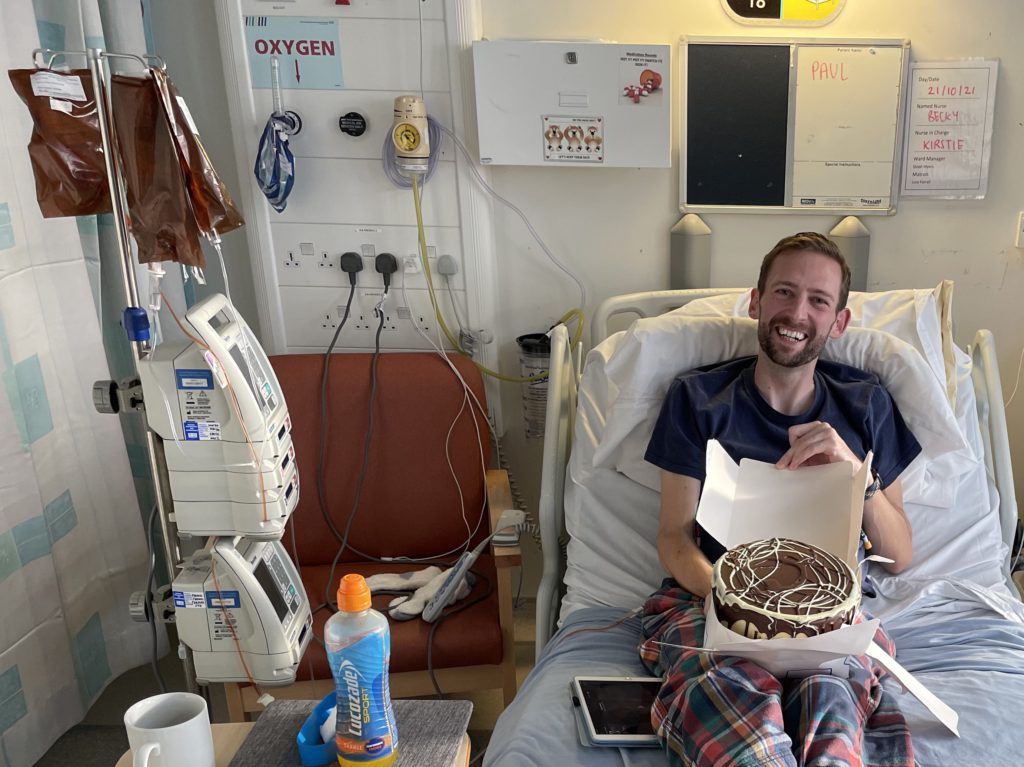As chemo involves lots of blood tests and intravenous medicines, it’s common to have a semi-permanent PICC line or central line implanted to make these easier and to reduce the number of needles and cannulas needed. As an example, in one of my chemo sessions, where I didn’t have a line installed, had to be abandoned after 7 attempts to get a cannula in my hand failed.
There are different types of lines. I had a PICC line for my first type of chemo (DA-EPOCH-R). For my second type (R-GDP) and my CAR-T therapy, I had a Tesio central line fitted.
PICC lines (Peripherally Inserted Central Catheter)
PICC lines run from your arm to a large vein near the heart. The installation of my PICC line was very straightforward. A specialist nurse on the haematology day unit did the installation. The vein in my arm was located using an ultrasound machine. I was injected with local anaesthetic and the line was then inserted. It wasn’t painful and took about an hour.
The line had to be flushed and the dressing changed weekly. My CNS did this for me in the clinic. My line occasionally got blocked, but the nurses had a procedure that dealt with that.
Getting the dressing wet loosens it and can lead to infection. So, there was a lot of trial and error involved in learning how to shower with the PICC line. Despite what the internet says, don’t use cling film, it doesn’t work at all! I bought this PICC sleeve, which was brilliant.
Having the PICC line removed wasn’t too bad,there was a little bit of pain as the clamp was removed but otherwise, it was ok. I have a very small scar on my arm where the line was.
More information on PICC lines are available on the Macmillian website.
Central lines (tunnelled central venous catheter)
Central lines generally go into the chest rather than the arm. There are various types of them and you’ll often hear them referred to by the brand names Hickman, Groshong or Tesio.

Currently, I have a Tesio Line. This type of line was created for dialysis patients, but it’s used in people having stem cell transplants and CAR-T therapy as the process of harvesting the cells is similar to what happens during dialysis.
The implant procedure for the Tesio line was much more involved than a PICC line. Whereas my PICC line was done on the day unit by a specialist nurse, the Tesio line was done by a full operating theatre team led by a radiologist. The procedure was very uncomfortable but not painful. It took about 45 minutes, but I was in the department for 4 hours for observations, waiting etc.
They have a preference for installing the line on the right side of the chest, but it all depends on how your veins are, which will be examined by ultrasound before the procedure starts.
The day following the insertion of the line was difficult. The dressing applied to the insertion site near my collar bone was very tight, this was to stop any bleeding. However, this made any movement in my neck painful, and even swallowing was uncomfortable. The next day it was back to the haematology day unit for a dressing change. This made things a lot more comfortable, though I was still sore for several days afterwards. A couple of stitches were used to close the insertion site, these were removed 10-days afterwards.
A tip, if you have chest hair shave it, all of it, before having the procedure. I shaved the hair on my pecs but not in between them, which was a mistake as the lumens of the catheter were taped to the middle of my chest. The dressings they apply are quite large and pulling them off chest hair is hell!
